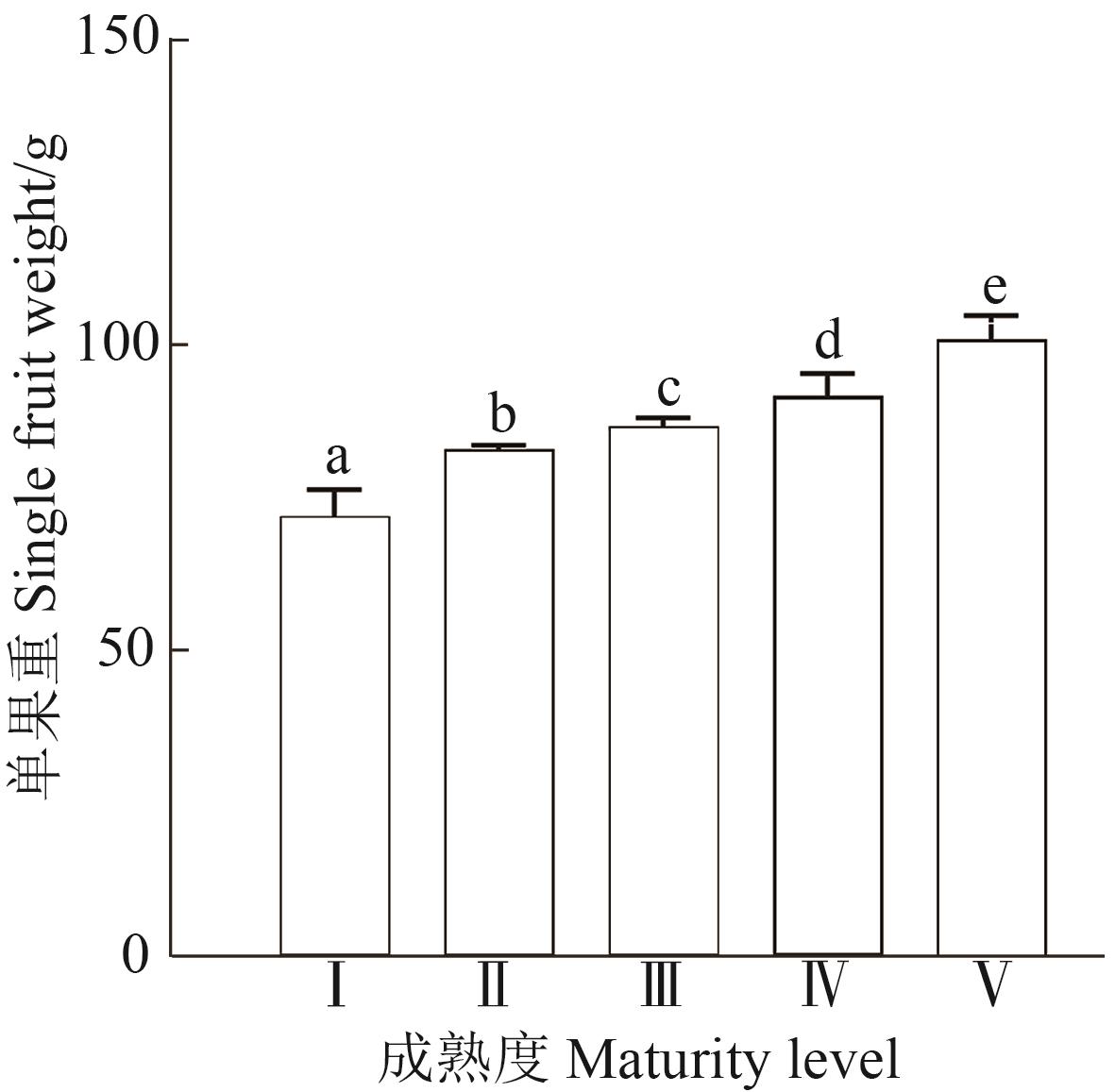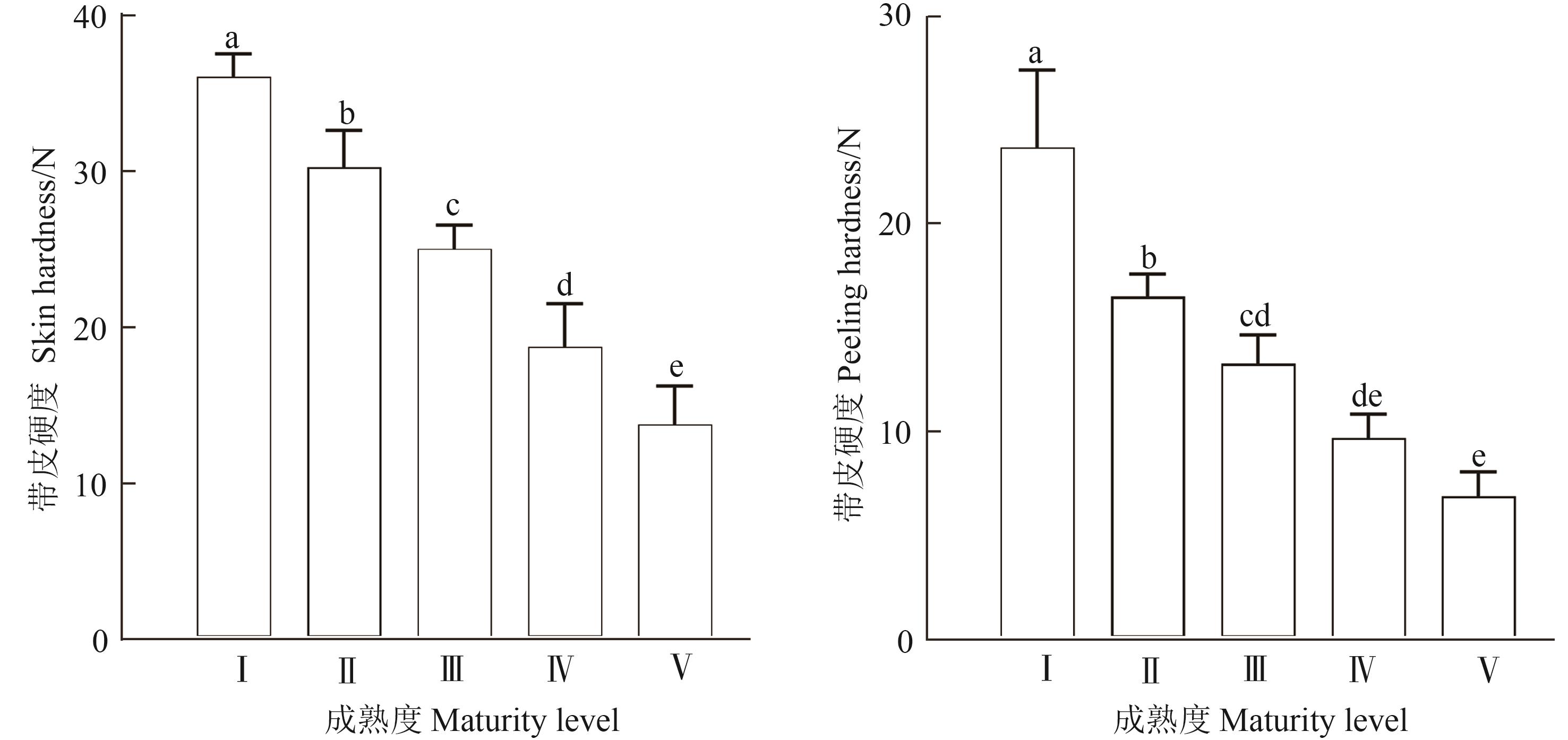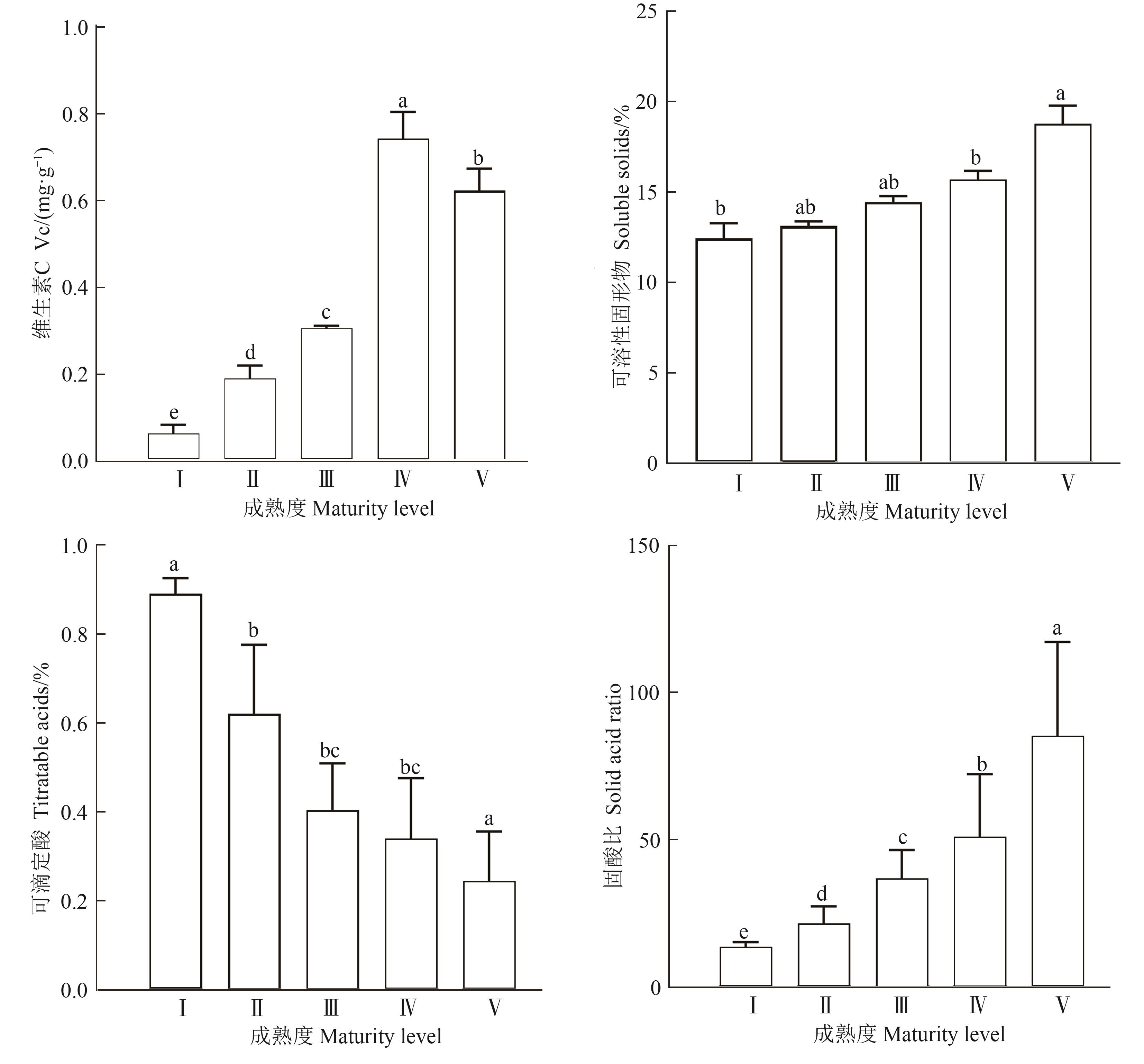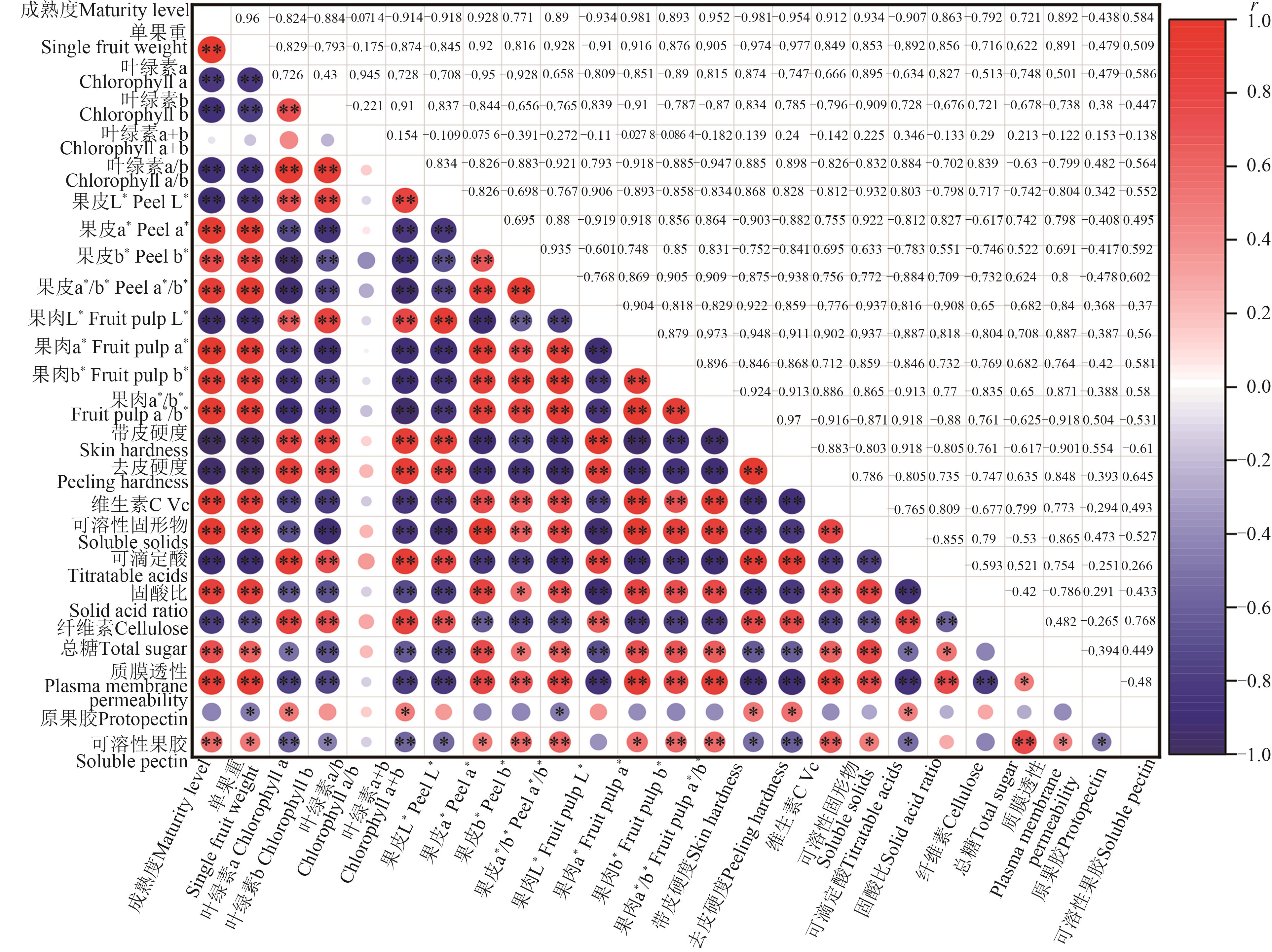




















中国农业科技导报 ›› 2025, Vol. 27 ›› Issue (2): 158-169.DOI: 10.13304/j.nykjdb.2023.0429
• 食品质量 加工储运 • 上一篇
王如月1,2( ), 虎海防2,3, 罗莎莎1,2, 甄紫怡1,2, 徐业勇3, 胡晓静1(
), 虎海防2,3, 罗莎莎1,2, 甄紫怡1,2, 徐业勇3, 胡晓静1( )
)
收稿日期:2023-06-03
接受日期:2024-04-22
出版日期:2025-02-15
发布日期:2025-02-14
通讯作者:
胡晓静
作者简介:王如月 E-mail:1547093665@qq.com;
基金资助:
Ruyue WANG1,2( ), Haifang HU2,3, Shasha LUO1,2, Ziyi ZHEN1,2, Yeyong XU3, Xiaojing HU1(
), Haifang HU2,3, Shasha LUO1,2, Ziyi ZHEN1,2, Yeyong XU3, Xiaojing HU1( )
)
Received:2023-06-03
Accepted:2024-04-22
Online:2025-02-15
Published:2025-02-14
Contact:
Xiaojing HU
摘要:
为研究不同成熟度对杏李果实品质的影响,筛选杏李适宜的采摘成熟度,以杏李‘风味皇后’为试验材料,对不同成熟度(Ⅰ、Ⅱ、Ⅲ、Ⅳ、Ⅴ)下单果重、果实颜色、果实硬度等指标变化规律进行方差、相关性和主成分分析。结果表明,随成熟度的增加,果皮红绿值(a*)、果肉红绿值(a*)、果皮蓝黄值(b*)、果肉蓝黄值(b*)、果皮综合比值(a*/b*)、果肉综合比值(a*/b*)均呈显著上升趋势,在整个成熟发育期间分别上升15.811、15.760、23.009、15.380、0.973和0.558,且与果实成熟度间呈极显著正相关;叶绿素a+b、果皮亮度值(L*)、果肉亮度值(L*)呈显著下降趋势,在成熟期间分别下降17.230 μg·cm-3、11.460、13.492;单果重、可溶性固形物、固酸比和质膜透性均随着采收成熟度的提高呈显著上升趋势,在成熟度Ⅴ时各指标含量分别为101.500 g、18.780%、85.535%和62.050%,且与成熟度间呈极显著相关。带皮硬度、去皮硬度、可滴定酸随着成熟度的增加呈显著下降趋势,均在成熟度Ⅴ时达到最低值,分别为13.770 N、6.886 N、0.246%,与采收成熟度呈极显著负相关。主成分分析结果显示,不同成熟度果实品质表现为:成熟度Ⅴ>成熟度Ⅳ>成熟度Ⅲ>成熟度Ⅱ>成熟度Ⅰ。根据生产需求并综合经济效益考虑,成熟度Ⅰ和Ⅱ不适宜采摘,成熟度Ⅳ和Ⅴ品质和口感较好,但果实软化严重,因此可选择成熟度Ⅲ作为适宜采收成熟度。研究结果为杏李后续研究生产等提供理论基础和科学依据。
中图分类号:
王如月, 虎海防, 罗莎莎, 甄紫怡, 徐业勇, 胡晓静. 杏李不同采收成熟度果实品质分析[J]. 中国农业科技导报, 2025, 27(2): 158-169.
Ruyue WANG, Haifang HU, Shasha LUO, Ziyi ZHEN, Yeyong XU, Xiaojing HU. Fruit Quality Analysis of Prunus domestica × armeniaca at Different Harvest Maturity Levels[J]. Journal of Agricultural Science and Technology, 2025, 27(2): 158-169.
综合评分 Comprehensive score | 转色率 Color conversion rate | 多汁性 Juiciness | 甜度 Sweetness | 酸度 Acidity | 软硬度 Hardness |
|---|---|---|---|---|---|
| 0.0~3.9 | 绿色 Green | 不多 Not much | 无甜味 No sweet taste | 非常酸 Very sour | 很硬 Very hard |
| 4.0~7.9 | 3/4绿色 3/4 green | 有点多 A little much | 微甜 Slightly sweet | 很酸 Too sour | 硬 Hard |
| 8.0~11.9 | 2/3绿色 2/3 green | 较多 More | 较甜 Sweeter | 较酸 More sour | 较硬 More hard |
| 12.0~15.9 | 1/4绿色 1/4 green | 很多 Quite a lot | 很甜 Too sweet | 微酸或无酸 Slightly acid or no acid | 微硬 Microhardness |
| 16.0~20.0 | 绿色消失 Green disappears | 丰富 Abundant | 非常甜 Very sweet | 酸甜适宜 Sweet and sour | 非常软 Very soft |
表1 感官指标综合评分
Table 1 Comprehensive score of sensory indexes
综合评分 Comprehensive score | 转色率 Color conversion rate | 多汁性 Juiciness | 甜度 Sweetness | 酸度 Acidity | 软硬度 Hardness |
|---|---|---|---|---|---|
| 0.0~3.9 | 绿色 Green | 不多 Not much | 无甜味 No sweet taste | 非常酸 Very sour | 很硬 Very hard |
| 4.0~7.9 | 3/4绿色 3/4 green | 有点多 A little much | 微甜 Slightly sweet | 很酸 Too sour | 硬 Hard |
| 8.0~11.9 | 2/3绿色 2/3 green | 较多 More | 较甜 Sweeter | 较酸 More sour | 较硬 More hard |
| 12.0~15.9 | 1/4绿色 1/4 green | 很多 Quite a lot | 很甜 Too sweet | 微酸或无酸 Slightly acid or no acid | 微硬 Microhardness |
| 16.0~20.0 | 绿色消失 Green disappears | 丰富 Abundant | 非常甜 Very sweet | 酸甜适宜 Sweet and sour | 非常软 Very soft |

图1 不同采收成熟度果实的单果重注:不同小写字母表示不同成熟度间在 P<0.05 水平差异显著。
Fig. 1 Single fruit weight of fruits with different harvest maturity levelsNote:Different lowercase letters indicate significant differences between different maturity levels at P<0.05 level.
成熟度 Maturity level | 叶绿素a Chlorophyll a/(μg·cm-3) | 叶绿素b Chlorophyll b/(μg·cm-3) | 叶绿素a/b Chlorophyll a/b | 叶绿素a+b Chlorophyll a+b/(μg·cm-3) |
|---|---|---|---|---|
| Ⅰ | 21.390±1.121 a | 23.040±1.520 a | 0.930±0.020 a | 44.430±2.630 a |
| Ⅱ | 13.750±0.952 b | 21.720±0.350 ab | 0.650±0.030 a | 35.460±1.080 b |
| Ⅲ | 12.350±0.408 bc | 19.390±2.730 abc | 0.650±0.070 a | 31.730±2.880 bc |
| Ⅳ | 11.620±0.289 c | 17.890±0.770 bc | 0.650±0.030 a | 29.520±0.935 c |
| Ⅴ | 11.500±0.817 c | 15.700±2.870 c | 0.890±0.380 a | 27..200±3.190 c |
表2 不同采收成熟度下果皮叶绿素含量
Table 2 Chlorophyll content in fruit peel under different harvesting maturity levels
成熟度 Maturity level | 叶绿素a Chlorophyll a/(μg·cm-3) | 叶绿素b Chlorophyll b/(μg·cm-3) | 叶绿素a/b Chlorophyll a/b | 叶绿素a+b Chlorophyll a+b/(μg·cm-3) |
|---|---|---|---|---|
| Ⅰ | 21.390±1.121 a | 23.040±1.520 a | 0.930±0.020 a | 44.430±2.630 a |
| Ⅱ | 13.750±0.952 b | 21.720±0.350 ab | 0.650±0.030 a | 35.460±1.080 b |
| Ⅲ | 12.350±0.408 bc | 19.390±2.730 abc | 0.650±0.070 a | 31.730±2.880 bc |
| Ⅳ | 11.620±0.289 c | 17.890±0.770 bc | 0.650±0.030 a | 29.520±0.935 c |
| Ⅴ | 11.500±0.817 c | 15.700±2.870 c | 0.890±0.380 a | 27..200±3.190 c |
指标 Index | 成熟度 Maturity level | L*:亮度值 Brightness value | a*:红绿值 Red green value | b*:黄蓝值 Yellow blue value | a*/b*:综合比值 Comprehensive ratio |
|---|---|---|---|---|---|
果皮颜色 Skin color | Ⅰ | 61.618±1.162 a | -9.030±1.397 d | 11.923±0.559 c | -0.778±0.111 d |
| Ⅱ | 59.055±1.351 ab | -5.388±2.791 c | 32.589±2.380 ab | -0.170±0.099 c | |
| Ⅲ | 57.050±2.883 b | -2.738±1.980 bc | 30.132±1.021 b | -0.090±0.066 bc | |
| Ⅳ | 54.313±0.823 c | -0.996±1.090 b | 33.211±1.525 a | -0.029±0.029 b | |
| Ⅴ | 50.158±2.210 d | 6.781±0.744 a | 34.932±1.233 a | 0.195±0.023 a | |
果肉颜色 Fruit flesh color | Ⅰ | 56.497±0.494 a | -5.553±1.360 e | 22.049±2.583 c | -0.286±0.104 d |
| Ⅱ | 55.602±1.147 a | -2.042±1.416 d | 29.270±1.392 b | -0.070±0.049 c | |
| Ⅲ | 51.789±0.613 b | 2.553±1.344 c | 31.927±2.007 b | 0.082±0.044 b | |
| Ⅳ | 50.391±0.131 b | 6.781±0.997 b | 31.598±1.186 b | 0.214±0.023 a | |
| Ⅴ | 43.005±1.638 c | 10.207±1.179 a | 37.429±1.822 a | 0.272±0.021 a |
表3 不同采收成熟度果实的果皮和果肉颜色色度值
Table 3 Color and chromaticity values of peel and flesh of fruits with different harvest maturity levels
指标 Index | 成熟度 Maturity level | L*:亮度值 Brightness value | a*:红绿值 Red green value | b*:黄蓝值 Yellow blue value | a*/b*:综合比值 Comprehensive ratio |
|---|---|---|---|---|---|
果皮颜色 Skin color | Ⅰ | 61.618±1.162 a | -9.030±1.397 d | 11.923±0.559 c | -0.778±0.111 d |
| Ⅱ | 59.055±1.351 ab | -5.388±2.791 c | 32.589±2.380 ab | -0.170±0.099 c | |
| Ⅲ | 57.050±2.883 b | -2.738±1.980 bc | 30.132±1.021 b | -0.090±0.066 bc | |
| Ⅳ | 54.313±0.823 c | -0.996±1.090 b | 33.211±1.525 a | -0.029±0.029 b | |
| Ⅴ | 50.158±2.210 d | 6.781±0.744 a | 34.932±1.233 a | 0.195±0.023 a | |
果肉颜色 Fruit flesh color | Ⅰ | 56.497±0.494 a | -5.553±1.360 e | 22.049±2.583 c | -0.286±0.104 d |
| Ⅱ | 55.602±1.147 a | -2.042±1.416 d | 29.270±1.392 b | -0.070±0.049 c | |
| Ⅲ | 51.789±0.613 b | 2.553±1.344 c | 31.927±2.007 b | 0.082±0.044 b | |
| Ⅳ | 50.391±0.131 b | 6.781±0.997 b | 31.598±1.186 b | 0.214±0.023 a | |
| Ⅴ | 43.005±1.638 c | 10.207±1.179 a | 37.429±1.822 a | 0.272±0.021 a |

图2 不同采收成熟度果实的果实带皮硬度和去皮硬度注:不同小写字母表示不同成熟度间在P<0.05水平差异显著。
Fig. 2 Fruit peel hardness and peel removal hardness of fruits with different harvest maturity levelsNote:Different lowercase letters indicate significant differences between different maturity levels at P<0.05 level.

图3 不同采收成熟度果实的维生素C、可溶性固形物、可滴定酸和固酸比注:不同小写字母表示不同成熟度间在 P<0.05 水平差异显著。
Fig. 3 Vitamin C, soluble solids, titratable acids and solid acid ratio of fruits with different harvest maturity levelsNote:Different lowercase letters indicate significant differences between different maturity levels at P<0.05 level.
成熟度 Maturity level | 纤维素 Cellulose | 总糖 Total sugar | 质膜透性 Plasma membrane permeability | 原果胶 Protopectin | 可溶性果胶 Soluble pectin |
|---|---|---|---|---|---|
| Ⅰ | 0.560±0.181 a | 15.260±0.630 b | 35.180±3.980 c | 0.780±0.350 a | 0.190±0.080 b |
| Ⅱ | 0.383±0.124 b | 16.710±2.190 ab | 41.170±12.240 bc | 0.570±0.600 a | 0.340±0.110 ab |
| Ⅲ | 0.133±0.021 c | 17.240±0.650 ab | 51.870±3.900 ab | 0.440±0.040 a | 0.350±0.120 ab |
| Ⅳ | 0.127±0.049 c | 20.680±7.460 ab | 57.420±6.960 a | 0.440±0.220 a | 0.530±0.210 a |
| Ⅴ | 0.140±0.029 c | 23.700±3.520 a | 62.050±0.480 a | 0.430±0.120 a | 0.410±0.160 ab |
表4 不同采收成熟度果实的纤维素、总糖、质膜透性及果胶含量
Table 4 Cellulose, total sugar, plasma membrane permeability and pectin content of fruits with different harvest maturities (%)
成熟度 Maturity level | 纤维素 Cellulose | 总糖 Total sugar | 质膜透性 Plasma membrane permeability | 原果胶 Protopectin | 可溶性果胶 Soluble pectin |
|---|---|---|---|---|---|
| Ⅰ | 0.560±0.181 a | 15.260±0.630 b | 35.180±3.980 c | 0.780±0.350 a | 0.190±0.080 b |
| Ⅱ | 0.383±0.124 b | 16.710±2.190 ab | 41.170±12.240 bc | 0.570±0.600 a | 0.340±0.110 ab |
| Ⅲ | 0.133±0.021 c | 17.240±0.650 ab | 51.870±3.900 ab | 0.440±0.040 a | 0.350±0.120 ab |
| Ⅳ | 0.127±0.049 c | 20.680±7.460 ab | 57.420±6.960 a | 0.440±0.220 a | 0.530±0.210 a |
| Ⅴ | 0.140±0.029 c | 23.700±3.520 a | 62.050±0.480 a | 0.430±0.120 a | 0.410±0.160 ab |
成熟度 Maturity level | 转色率 Color conversion rate | 多汁性 Juiciness | 甜度 Sweetness | 酸度 Acidity | 软硬度 Hardness |
|---|---|---|---|---|---|
| Ⅰ | 2.070±0.750 e | 2.830±0.870 d | 1.270±0.960 e | 0.970±0.570 e | 1.100±0.300 e |
| Ⅱ | 5.470±0.930 d | 5.030±1.450 d | 4.670±0.550 d | 6.200±1.420 d | 5.300±0.950 d |
| Ⅲ | 9.130±1.430 c | 10.130±1.590 c | 9.700±1.510 c | 9.300±1.250 c | 10.330±1.310 c |
| Ⅳ | 12.870±1.340 b | 18.500±1.350 a | 14.000±1.510 b | 14.330±1.600 b | 15.100±0.660 b |
| Ⅴ | 18.340±1.900 a | 14.400±1.610 b | 18.230±1.890 a | 18.600±1.440 a | 19.500±0.700 a |
表5 不同采收成熟度果实的感官指标得分
Table 5 Scores of sensory indicators of fruits with different harvest maturity levels
成熟度 Maturity level | 转色率 Color conversion rate | 多汁性 Juiciness | 甜度 Sweetness | 酸度 Acidity | 软硬度 Hardness |
|---|---|---|---|---|---|
| Ⅰ | 2.070±0.750 e | 2.830±0.870 d | 1.270±0.960 e | 0.970±0.570 e | 1.100±0.300 e |
| Ⅱ | 5.470±0.930 d | 5.030±1.450 d | 4.670±0.550 d | 6.200±1.420 d | 5.300±0.950 d |
| Ⅲ | 9.130±1.430 c | 10.130±1.590 c | 9.700±1.510 c | 9.300±1.250 c | 10.330±1.310 c |
| Ⅳ | 12.870±1.340 b | 18.500±1.350 a | 14.000±1.510 b | 14.330±1.600 b | 15.100±0.660 b |
| Ⅴ | 18.340±1.900 a | 14.400±1.610 b | 18.230±1.890 a | 18.600±1.440 a | 19.500±0.700 a |

图4 不同成熟度各品质指标相关性热图注:图中红色代表正相关,蓝色代表负相关。*和**分别表示在P<0.05和P<0.01水平相关显著。
Fig. 4 Correlation heat map of each quality index under different maturityNote:Red in the figure represents positive correlation, blue represents negative correlation. * and ** indicate significant correlations at P<0.05 and P<0.01 levels,respectively.
| 性状Trait | 主成分Principal component | ||
|---|---|---|---|
| 1 | 2 | 3 | |
| 带皮硬度 Skin hardness | -0.97 | -0.01 | 0.11 |
| 去皮硬度 Peeling hardness | -0.97 | 0.13 | 0.01 |
| 单果重 Single fruit weight | 0.96 | -0.03 | -0.10 |
| 维生素 Vc | 0.89 | 0.00 | 0.02 |
| 纤维素 Cellulose | -0.81 | 0.22 | 0.15 |
| 可溶性固形物 Soluble solids | 0.91 | 0.39 | -0.02 |
| 可滴定酸 Titratable acids | -0.93 | 0.20 | 0.14 |
| 固酸比 Solid acid ratio | 0.83 | 0.13 | -0.38 |
| 总糖 Total sugar | 0.71 | 0.37 | 0.47 |
| 质膜透性 Plasma membrane permeability | 0.89 | -0.02 | -0.20 |
| 原果胶 Protopectin | -0.48 | 0.26 | -0.39 |
| 可溶性果胶 Soluble pectin | 0.61 | -0.12 | 0.71 |
| 叶绿素a Chlorophyll a | -0.89 | 0.38 | -0.05 |
| 叶绿素b Chlorophyll b | -0.88 | -0.29 | -0.02 |
| 叶绿素a/b Chlorophyll a/b | -0.13 | 0.92 | 0.16 |
| 叶绿素a+b Chlorophyll a+b | -0.95 | 0.09 | -0.04 |
| 果皮L* Peel L* | -0.91 | -0.25 | -0.01 |
| 果皮a* Peel a* | 0.92 | 0.23 | -0.02 |
| 果皮b* Peel b* | 0.84 | -0.37 | 0.12 |
| 果皮a/b* Peel a/b* | 0.94 | -0.19 | 0.06 |
| 果肉L* Fruit pulp L* | -0.90 | -0.31 | 0.19 |
| 果肉a* Fruit pulp a* | 0.97 | 0.12 | -0.05 |
| 果肉b* Fruit pulp b* | 0.92 | 0.00 | 0.06 |
| 果肉a/b* Fruit pulp a/b* | 0.97 | -0.06 | -0.04 |
| 初始特征值 Initial eigenvalue | 17.83 | 1.98 | 1.22 |
| 贡献率 Contribution rate/% | 74.28 | 8.25 | 5.07 |
| 累计贡献率 Accumulated contribution rate/% | 74.28 | 82.53 | 87.60 |
表6 因子得分、初始特征值及方差贡献率
Table 6 Factor score, initial eigenvalue and variance contribution rate
| 性状Trait | 主成分Principal component | ||
|---|---|---|---|
| 1 | 2 | 3 | |
| 带皮硬度 Skin hardness | -0.97 | -0.01 | 0.11 |
| 去皮硬度 Peeling hardness | -0.97 | 0.13 | 0.01 |
| 单果重 Single fruit weight | 0.96 | -0.03 | -0.10 |
| 维生素 Vc | 0.89 | 0.00 | 0.02 |
| 纤维素 Cellulose | -0.81 | 0.22 | 0.15 |
| 可溶性固形物 Soluble solids | 0.91 | 0.39 | -0.02 |
| 可滴定酸 Titratable acids | -0.93 | 0.20 | 0.14 |
| 固酸比 Solid acid ratio | 0.83 | 0.13 | -0.38 |
| 总糖 Total sugar | 0.71 | 0.37 | 0.47 |
| 质膜透性 Plasma membrane permeability | 0.89 | -0.02 | -0.20 |
| 原果胶 Protopectin | -0.48 | 0.26 | -0.39 |
| 可溶性果胶 Soluble pectin | 0.61 | -0.12 | 0.71 |
| 叶绿素a Chlorophyll a | -0.89 | 0.38 | -0.05 |
| 叶绿素b Chlorophyll b | -0.88 | -0.29 | -0.02 |
| 叶绿素a/b Chlorophyll a/b | -0.13 | 0.92 | 0.16 |
| 叶绿素a+b Chlorophyll a+b | -0.95 | 0.09 | -0.04 |
| 果皮L* Peel L* | -0.91 | -0.25 | -0.01 |
| 果皮a* Peel a* | 0.92 | 0.23 | -0.02 |
| 果皮b* Peel b* | 0.84 | -0.37 | 0.12 |
| 果皮a/b* Peel a/b* | 0.94 | -0.19 | 0.06 |
| 果肉L* Fruit pulp L* | -0.90 | -0.31 | 0.19 |
| 果肉a* Fruit pulp a* | 0.97 | 0.12 | -0.05 |
| 果肉b* Fruit pulp b* | 0.92 | 0.00 | 0.06 |
| 果肉a/b* Fruit pulp a/b* | 0.97 | -0.06 | -0.04 |
| 初始特征值 Initial eigenvalue | 17.83 | 1.98 | 1.22 |
| 贡献率 Contribution rate/% | 74.28 | 8.25 | 5.07 |
| 累计贡献率 Accumulated contribution rate/% | 74.28 | 82.53 | 87.60 |
成熟度 Maturity level | 主成分Principal component | 综合得分Comprehensive score | 排名 Ranking | ||
|---|---|---|---|---|---|
| 1 | 2 | 3 | |||
| Ⅰ | -6.530 | 1.350 | -0.270 | -4.750 | 5 |
| Ⅱ | -2.120 | -1.240 | 0.380 | -1.660 | 4 |
| Ⅲ | 0.430 | -1.020 | -0.210 | 0.220 | 3 |
| Ⅳ | 2.780 | -0.640 | 0.480 | 2.030 | 2 |
| Ⅴ | 5.450 | 1.550 | -0.380 | 4.160 | 1 |
表7 不同成熟度综合得分及排名
Table 7 Comprehensive score and ranking of different maturity levels
成熟度 Maturity level | 主成分Principal component | 综合得分Comprehensive score | 排名 Ranking | ||
|---|---|---|---|---|---|
| 1 | 2 | 3 | |||
| Ⅰ | -6.530 | 1.350 | -0.270 | -4.750 | 5 |
| Ⅱ | -2.120 | -1.240 | 0.380 | -1.660 | 4 |
| Ⅲ | 0.430 | -1.020 | -0.210 | 0.220 | 3 |
| Ⅳ | 2.780 | -0.640 | 0.480 | 2.030 | 2 |
| Ⅴ | 5.450 | 1.550 | -0.380 | 4.160 | 1 |
| 1 | 杨绍彬,李芳东,杜红岩,等.杏李种间杂交品种适宜授粉组合筛选试验[J].中国果树,2008(5):28-30. |
| 2 | 王春弘,朱凤云.杂交杏李高效栽植及授粉技术研究[J].广东农业科学,2011,38(19):50-51. |
| 3 | 杨飞,韦茜,刘朝英,等.美国杏李种植管理技术[J].中国园艺文摘,2011,27(3):155-156. |
| 4 | MACHADO F L D C, COSTA J M C D, TEIXEIRA A D S, et al.. The influence of rootstock and time of harvest on the fruit quality during storage of in two grapefruit cultivars [J]. Acta Sci. Agron., 2015, 37(3): 339-346. |
| 5 | PAILLY O, TISON G, AMOUROUX A. Harvest time and storage conditions of ‘Star Ruby’ grapefruit (Citrus paradisi Macf.) for short distance summer consumption [J]. Postharvest Biol. Technol., 2004,34(1):65-73. |
| 6 | UNDURRAGA P L, OLARTA J A, RETAMALES J B, et al.. Effect of maturity and storage temperature on the development of peteca in lemons [Citrus limon (L.) Burm. F.] cv. Eureka [J]. Sci. Hortic., 2009, 122(1): 56-61. |
| 7 | 张志刚,刘玉芳,李长城,等.不同成熟度对杏果实品质的影响[J].浙江农业学报,2021,33(8):1402-1408. |
| ZHANG Z G, LIU Y F, LI C C, et al.. Effect of different maturity on fruit quality of apricot [J].Acta Agric. Zhejiangensis, 2021,33(8):1402-1408. | |
| 8 | 侯晓健,张浩宇,张光弟,等.不同成熟度红梅杏品质及挥发性物质研究[J].食品与发酵工业,2022,48(10):177-182. |
| HOU X J, ZHANG H Y, ZHANG G D, et al.. Study on the quality and volatile compounds of Hongmei apricot with different maturity [J]. Food Ferment. Ind., 2022,48(10):177-182. | |
| 9 | 薛晓敏,韩雪平,王贵平,等.不同成熟度对李果实品质的影响[J].经济林研究,2020,38(3):26-36. |
| XUE X M, HAN X P, WANG G P, et al.. Effects of different maturities on characteristics of plum fruit quality [J].Non-Wood For. Res., 2020,38(3):26-36. | |
| 10 | 杜改改,李泰山,刁松锋,等.6个杏李品种果实甜酸风味品质分析[J].果树学报,2017,34(1):41-49. |
| DU G G, LI T S, DIAO S F, et al.. Evaluation of flavor quality in relation to sugars and acids of six Prunus domestica × armeniaca cultivars [J]. J. Fruit Sci., 2017,34(1):41-49. | |
| 11 | 李泰山.负载量对杏李‘味帝’产量及果实品质的影响[D].北京:中国林业科学研究院,2024. |
| LI T S. Yield, sensory profile, and physico-chemical quality attributes of Prunus domestica×armeniaca ‘Weidi Fruits’ as affected by crop load [D]. Beijing: Chinese Academy of Forestry, 2024. | |
| 12 | 王如月,罗莎莎,甄紫怡,等.风味皇后杏李果实不同成熟度特性研究[J].浙江农业学报,2023,35(12):2865-2877. |
| WANG R Y, LUO S S, ZHEN Z Y, et al.. Study on the characteristics of different maturity of apricot plum Flavor Queen fruit [J]. Acta Agric. Zhejiangensis, 2023,35(12):2865-2877. | |
| 13 | 刘彬,张云秀,李芳,等.新疆野苹果果实Vc及可溶性蛋白含量的测定分析[J].天津农学院学报,2016,23(4):14-17. |
| LIU B, ZHANG Y X, LI F, et al.. Measurement and comparison of vitamin C and soluble protein content of Malus sieversii fruits [J]. J. Tianjin Agric. Univ., 2016,23(4):14-17. | |
| 14 | 王明霞,孙中平,于唐丽,等.不同种类及相同种类不同品种蔬菜的粗纤维含量分析[J].科技资讯,2018,16(13):212-213. |
| 15 | 李清斌,孙军波,符国槐,等.新旧膜棚内小气候差异及其对樱桃番茄果实产量和品质的影响[J].浙江农业学报,2016,28(3):435-440. |
| LI Q B, SUN J B, FU G H,et al..Effects of different microclimatic factors in greenhouse with new greenhouse film or old one on yield and quality of cherry tomato [J]. Acta Agric. Zhejiangensis, 2016,28(3):435-440. | |
| 16 | 张宪政.植物生理学实验技术[M].沈阳:辽宁科学技术出版社,1989: 158-159 . |
| 17 | 刁俊明,曾宪录,朱远平,等.脐橙果实大小对果实感官品质和可溶性固形物含量的影响[J].广东农业科学,2015,42(23):82-85. |
| DIAO J M, ZENG X L, ZHU Y P, et al.. Effects of fruit size on sensory quality and soluble solid content of Citrus sinensis [J]. Guangdong Agric. Sci., 2015,42(23):82-85. | |
| 18 | 刘雪峰,胡德玉,袁项成,等.海拔和采收期对奥林达夏橙果实品质的影响[J].南方农业,2017,11(4):52-55. |
| 19 | 马培恰,吴文,王平,等.贡柑采收期果肉颜色变化与果实成熟度的关系研究[J].广东农业科学,2010,37(10):63-64. |
| MA P Q, WU W, WANG P, et al.. Relationship between the color change of Citrus Gonggan flesh and the maturity in harvest time [J]. Guangdong Agric. Sci., 2010,37(10):63-64. | |
| 20 | 梁森苗,朱婷婷,张淑文,等.杨梅果实发育成熟度与颜色变化规律探究[J].浙江农业科学,2019,60(6):879-882. |
| 21 | 张淑文,梁森苗,郑锡良,等.杨梅优株果实品质的主成分分析及综合评价[J].果树学报,2018,35(8):977-986. |
| ZHANG S W, LIANG S M, ZHENG X L,et al..Principal component analysis and comprehensive evaluation of fruit quality in some advanced selections of Chinese bayberry [J]. J.Fruit Sci., 2018,35(8):977-986. | |
| 22 | LEWIS D H, BLOOR S J, SCHWINN K E.Flavonoid and carotenoid pigments in flower tissue of Sandersonia aurantiaca (Hook.) [J]. Sci. Hortic., 1998,72(3/4):179-192. |
| 23 | 高华君,王少敏,王江勇.套袋对苹果果皮花青苷合成及着色的影响[J].果树学报,2006,23(5):750-755. |
| GAO H J, WANG S M, WANG J Y.Effect of bagging on anthocyanin biosynthesis and pigmentation in apple skin [J]. J.Fruit Sci., 2006,23(5):750-755. | |
| 24 | 李慧敏,郑洁新,曾凯芳,等.不同采收成熟度对蜜奈夏橙果实营养品质的影响[J].食品工业科技,2023,44(19):390-400. |
| LI H M, ZHENG J X, ZENG K F,et al..Effect of different harvest maturity on the nutritional quality of midknight Valencia orange fruit [J]. Sci. Technol. Food Ind., 2023,44(19):390-400. | |
| 25 | IGLESIAS D J, CERCÓS M, COLMENERO-FLORES J M, et al.. Physiology of citrus fruiting [J]. Brazilian J. Plant Physiol., 2007, 19: 333-362. |
| 26 | 张群,舒楠,张维,等.不同采收期黄桃的品质特性和微观结构变化[J].保鲜与加工,2021,21(4):29-34. |
| ZHANG Q, SHU N, ZHANG W,et al..Changes of quality characteristics and microstructures of yellow peaches in different harvest periods [J]. Storage Process., 2021,21(4):29-34. | |
| 27 | 王贵平,王金政,薛晓敏.李新品种“金红” 不同采收期果实品质及香气成分分析[J].江西农业学报,2015,27(10):88-91. |
| WANG G P, WANG J Z, XUE X M.Analysis of fruit quality and aromatic components of plum new variety “Jinhong” in different harvest times [J]. Acta Agric. Jiangxi, 2015,27(10):88-91. | |
| 28 | 张文英.不同采收期和贮藏方式对金红苹果贮藏品质的影响[D].北京:中国农业科学院,2007. |
| ZHANG W Y. Effects of different harvest date and storage methods on the storage quality of golden-red apple during storage [D]. Beijing: Chinese Academy of Agricultural Sciences, 2007. | |
| 29 | 张丽娜,李梦琪,朱亮,等.不同采收期对烟台苹果果实品质影响研究[J].中国果菜,2017,37(6):16-24. |
| ZHANG L N, LI M Q, ZHU L,et al..Effects of different harvest time on fruit quality of Yantai apple [J]. China Fruit Veget., 2017,37(6):16-24. | |
| 30 | 杨婷婷.不同采收成熟度对杏果品质劣变影响的研究[D].乌鲁木齐:新疆农业大学,2015. |
| YANG T T. Study on the effect of quality deterioration on the apricot fruits with different harvest maturity [D]. Urumqi: Xinjiang Agricultural University, 2024. | |
| 31 | INFANTE R, MENESES C, CRISOSTO C H. Preconditioning treatment maintains taste characteristic perception of ripe ‘September Sun’ peach following cold storage [J]. Int. J. Food Sci. Technol., 2010,44(5):1011-1016. |
| 32 | 陈国刚,刘琦,任雷厉,等.库尔勒香梨锈斑形成过程中果皮木质素和纤维素含量的变化研究[J].食品工业科技,2011,32(3):356-359. |
| CHEN G G, LIU Q, REN L L,et al..Study on the changes of the lignin and cellulose content of fruit peel during the formation of Kuerle pear rust [J]. Sci. Technol. Food Ind., 2011,32(3):356-359. |
| [1] | 王婷, 杜婧含, 张光弟, 王江龙, 贾毅男, 王玉, 包文毅. 宁南山区新优甘蓝品种品质及挥发性物质研究[J]. 中国农业科技导报, 2025, 27(1): 165-180. |
| [2] | 王学庆, 张波, 韩丽婷, 吕转转, 陈建军, 张竹林, 张军强, 杜建梅. 超高压处理对赤霞珠葡萄挥发性物质的影响[J]. 中国农业科技导报, 2024, 26(9): 146-158. |
| [3] | 白世践, 户金鸽, 李超, 蔡军社. 3种架式对‘新郁’葡萄栽培性状及果实品质的影响[J]. 中国农业科技导报, 2024, 26(8): 63-73. |
| [4] | 孙宪印, 牟秋焕, 米勇, 吕广德, 亓晓蕾, 孙盈盈, 尹逊栋, 王瑞霞, 吴科, 钱兆国, 赵岩, 高明刚. 基于GT双标图对小麦新品系的分类评价[J]. 中国农业科技导报, 2024, 26(7): 14-24. |
| [5] | 卢登洋, 童盼盼, 闫敏, 鲍荆凯, 刘鸣哲, 夏怡蕾, 吴翠云. 库尔勒香梨大果芽变的鉴定与评价[J]. 中国农业科技导报, 2024, 26(5): 52-64. |
| [6] | 石玉涛, 谢惠珍, 郑淑琳, 羽观华, 王飞权, 李力, 张渤, 李远华, 罗盛财. 武夷山地方茶树种质生化特性和茶多糖清除超氧阴离子自由基活性分析[J]. 中国农业科技导报, 2024, 26(5): 65-76. |
| [7] | 潘越, 王宝庆, 王季姣, 马勇, 李亚兰. 不同山葡萄品种CO2响应模型拟合及评价[J]. 中国农业科技导报, 2024, 26(4): 58-66. |
| [8] | 曹婷婷, 刘春, 范又维, 马力, 任志雨, 袁素霞, 张军云, 钱遵姚, 杨光炤. 不同氮素供应水平对微型盆栽月季生长发育的影响[J]. 中国农业科技导报, 2024, 26(2): 67-79. |
| [9] | 孟盼盼, 何海燕, 曹钰昕, 张丽欣, 吕清豪, 祁瑞林, 张红瑞. 5个栽培类型药菊分枝期抗旱性综合评价[J]. 中国农业科技导报, 2024, 26(2): 90-99. |
| [10] | 杨朝阳, 徐鹏, 苑铁键, 李晓琼, 彭冬根, 张振涛, 杨俊玲, 丁闯闯, 朱纪洲. 杂交构树低温干燥特性及品质研究[J]. 中国农业科技导报, 2024, 26(11): 157-170. |
| [11] | 张彩虹, 张力, 王卫民, 赵炯平, 韩丹, 许自成, 张仲文, 邵惠芳. 基于非靶向代谢组学的上部烟叶不同成熟度差异分析[J]. 中国农业科技导报, 2024, 26(10): 58-70. |
| [12] | 张海军, 张娟, 贾毅男, 王江龙, 冯丽. 不同架式对‘南太湖特早’葡萄果实香气成分及品质的影响[J]. 中国农业科技导报, 2024, 26(1): 201-213. |
| [13] | 李生梅, 庞博, 耿世伟, 宋武, 李红梅, 马茂森, 张茹, 王新燕, 高文伟. 棉花海陆回交群体盛铃期的光合特性及其生理基础[J]. 中国农业科技导报, 2024, 26(1): 40-51. |
| [14] | 胡永涛, 汪代斌, 陈益银, 杨超, 郑林林, 史宏志, 王建安. 不同成熟度鲜烟素质对烤后烟叶品质贡献度的研究[J]. 中国农业科技导报, 2023, 25(8): 157-164. |
| [15] | 杜彩艳, 鲁海燕, 熊艳竹, 孙曦, 孙秀梅, 普继雄, 张乃明. 连续两年沼液与化肥配施对桃生长及土壤理化性质的影响[J]. 中国农业科技导报, 2023, 25(8): 165-175. |
| 阅读次数 | ||||||
|
全文 |
|
|||||
|
摘要 |
|
|||||
 京公网安备11010802021197号
京公网安备11010802021197号